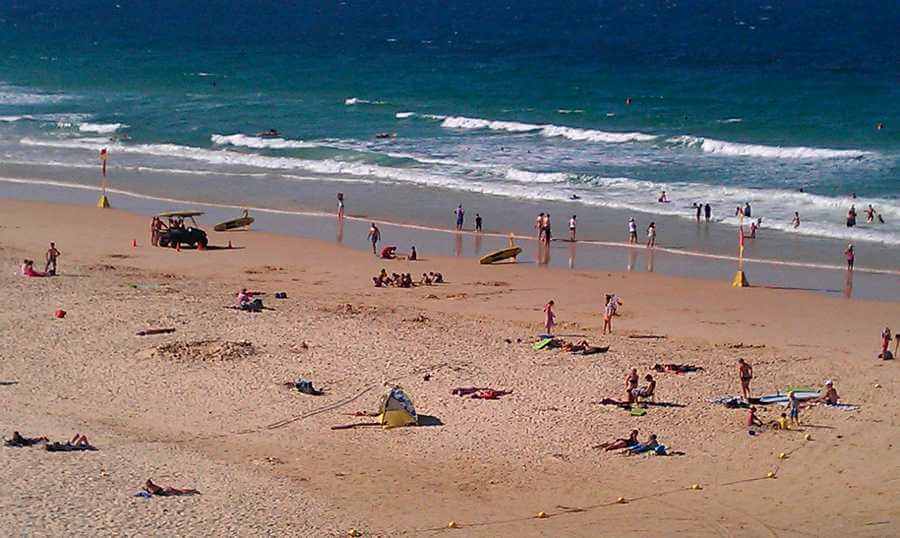Australia’s diverse landscapes, seascapes, and mangrove areas are all quite stunning to see firsthand. However, it is no secret that the country is known for its various dangerous wildlife. This is particularly true at the beaches that line the continent.
When it comes to visiting these pristine and enchanting beaches, beach safety is an absolute must.
While there are lots of marine life in the waters of Australia, from tropical fish to sharks, to venomous undersea creatures, when swimming be safe and look out for rips currents. Always swim at patrolled beaches as safety is important due to marine stingers or jellyfish frequent waters regularly.
Beach Safety Are Australian Beaches Dangerous?
The short answer to this question is yes. Australian beaches can be dangerous. As expressed before there are many dangers lurking on land and sea. In particular, water presents the biggest threat, especially with marine stingers.
They can be found in any waters but are most common in North Queensland usually around the coast. Marine stingers are known for their painful stings deriving from their tentacles which holds venom. Not every jellyfish is deadly, however, some are extremely deadly.
With this in mind, it is critical to never assume the beach waters are safe. In fact, visitors should never just enter the water without caution. The very step to beach safety is to ensure the beach is patrolled.
With over 10,000 beaches on its shorelines, not all Australian beaches are patrolled. It is essential to enter beach waters only on patrolled beaches. This is because in case something occurs, there is a greater chance of surviving and receiving medical help quickly.
Moreover, when hitting the beach for a fun-filled beach day, being aware is important. Marine stingers are one of the highest risks however because swimming is the most popular beach activity.
With so many people wanting to climb in the beautiful waters, it leads a lot of risks out there for marine stingers to strike. The number of beaches along Australia’s coastlines is also a reason for marine stingers to show up even though its mostly in the warmer areas in the northern region.
With so many different wildlife dangers, the probability of them showing up is pretty significant. This includes marine stingers, of course, but can also include crocodiles, kangaroos, etc. Some other issues that may arise around the beaches of Australia include turbulent waters, dangerous fish, stingrays, and even the sun.
Others even include steep drop-offs in the water that may take those strolling in beach waters by surprise. When speaking of turbulent waters, Australian waters are known for experiencing waves or breaks in the water, runback currents (areas where the beach is steep and backwash waves that carry people out to the ocean), and submerged objects.
The ocean floor is full of all sorts of wonders and unfortunately, submerged objects can be large or small as well sharp. These dangers should never be ignored and taken quite seriously.
Is It Safe to Swim In Australia?
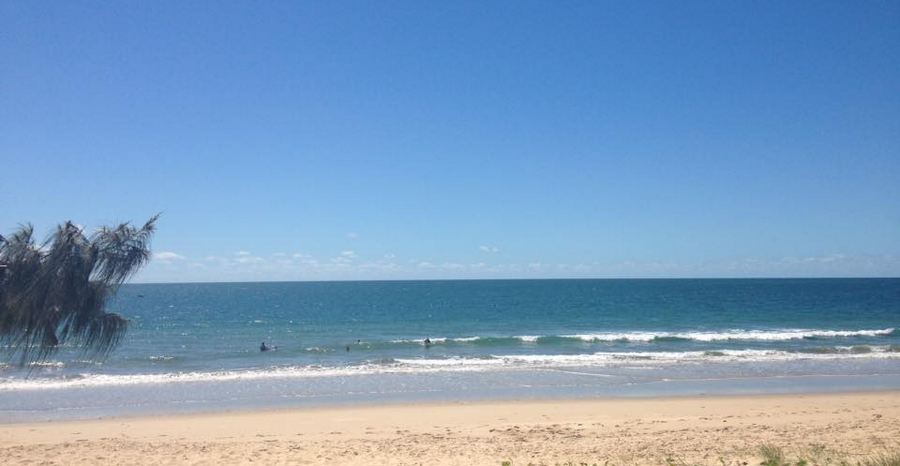
It can be safe to swim in Australia. As expressed before, guests should always attempt to swim at patrolled beaches. Marine stingers can be in any waters around Australia but are heavily found along northern coastlines, especially near Queensland.
While marine stingers can be dangerous and even deadly. but not all species are deadly. The deadliest species are considered to be Irukandji and Chironex fleckeri
This is especially true during peak times of the year when marine stingers flock to the coasts of Australia. Marine stinger season (in the extreme north end of Queensland) starts at the end of October extending through May.
The reason that dangerous marine stingers find their way most notably during these particular months is because the waters are the warmest then. The warm waters are where these creatures thrive and as May approaches heading into June the water temperatures drop since winter is then arriving.
While it may be tempting to hop into the waters during the winter since the stingers are not as frequent, that would be a bit too chilly. Moreover, this means that people shouldn’t be discouraged during the summer or fall months, rather just to practice beach safety while visiting during those months!
Why is Beach Safety Important?
Beach safety is exceptionally important. This may seem like common sense, it goes a bit further than the surface of simply being aware. We are all human and we can get distracted. This concept means that everyone at a public location like a beach should attempt to be aware.
If everyone is doing their part, someone will always be alert. Any beach can be dangerous but when at an Australian beach, extra precaution should always be taken to ensure the highest level of safety.
Once again, the first step should include going to a patrolled beach. Lifeguards will be readily onsite to perform CPR if needed and call for emergency help. Patrolled beaches are just simply safer.
While there are access points for unpatrolled beaches, those venturing there should not dare get into the water. It is entirely too risky.
Beach safety is important because of the varying dangers in the waters. The lifeguards are obviously helpful but extra eyes really give way to more opportunity to save a life. Unfortunately, marine stingers do not attack certain people, they can strike anyone.
This even includes children, pets, the elderly, etc. In any situation where someone may be stung by a marine stinger, beach safety comes into full swing. It is critical to get them to help immediately.
Children, pets or elderly people are more vulnerable and are at a lower survival rate. This is why ideally beach safety is everyone’s responsibility.
How to Stay Safe at the Beach?
It cannot be expressed enough that the number one way to practice beach safety is through going to beaches with lifeguards. Even still, there are other key ways to ensure ultimate beach safety. Below are some great tips to stay safe at the beach and make the most out of a beach day!
Stay Alert Of Potential Danger
Staying alert is not only helpful to a single individual but everyone around them. There is more to staying alert than just keeping a mindful eye of everything around. One of the biggest factors of staying alert is also attempting to stay sober.
Having a drink while fishing or sitting in the sand may be tempting but this impairs the ability to be fully alert. It is also not a good idea to swim while drinking. This is not to say avoid drinking all together rather its more to say do not overdo it. A clear mind is a safer mind!
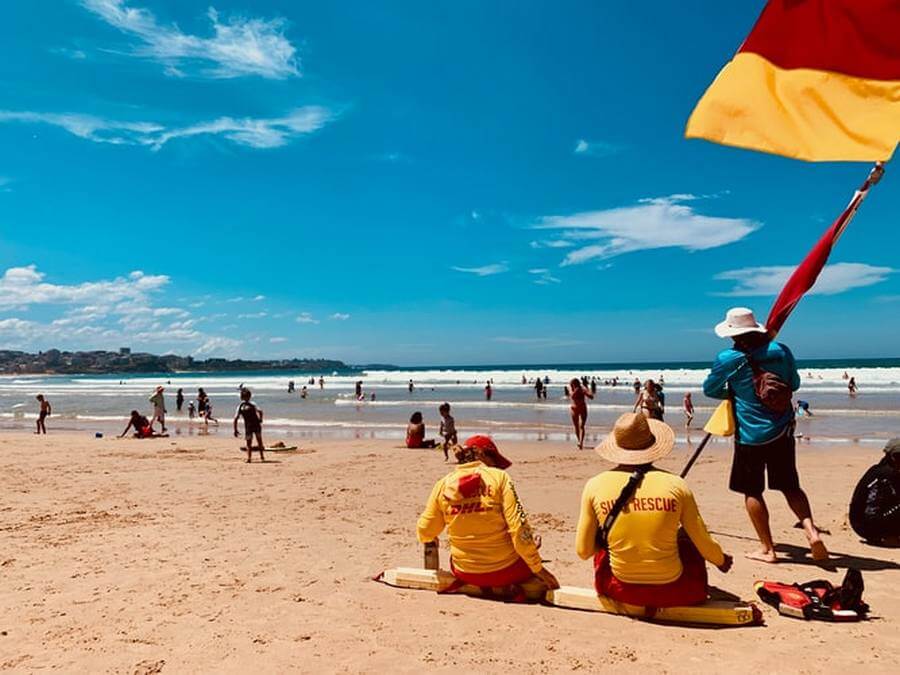
Establish a Swimming Buddy!
It has been stated to some of us since we were young to always have a buddy for safety. This transfers over to adulthood as well and never really stops being an essential part of everyday life.
When swimming, especially in Australian waters, always have a swim buddy. This gives people an extra set of eyes for seeing potential water threats. Never, ever, under ANY circumstance, should anyone swim alone.
Know-How to React in Case of a Sting
Even when swimming on a patrolled beach, the lifeguards may be busy or not there at the exact moment. If this is the case, it is important to know how to react in case of a marine stinger sting.
First, dial for emergency services by dialling 000. Doing this immediately helps get emergency services there as soon as possible.
Any trip to the beach should include bringing some basic first-aid things such as bandaids, gauze, vinegar, etc. These items can be helpful in treating a marine stinger sting. The sting needs to be addressed as soon as possible. Sometimes the stinger is visible and it should be removed.
If too much time has passed the skin around the stinger may have swollen a bit too much. This should be the first step to treating a sting. This only takes seconds to do if the stinger is visible. After removing the stinger (or if the stinger cannot be removed, move to this step), directly pour vinegar onto the sting site.
If no vinegar is available, it is suggested that saltwater be poured on the sting site instead. Both the vinegar and the saltwater will aid in drawing out the venom, preventing the spread of the venom and aiding in the prevention of serious infection.
If using vinegar never rub into the sting site, simply pour it.
Treating stings that are not deadly is only slightly different than deadly stings. Regular jellyfish, like Bluebottle
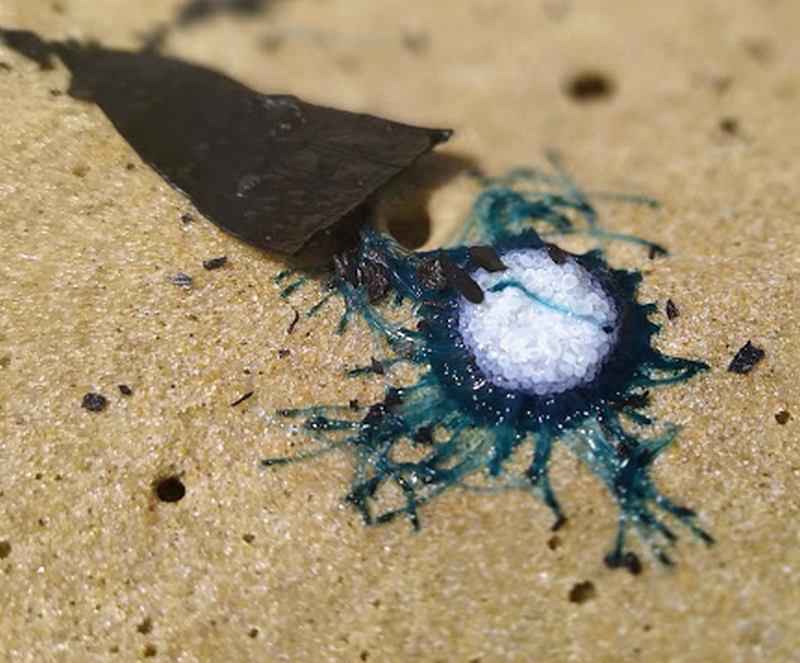
It will help get the blood flow going again in the affected area. Heat is said to do this best but ice packs can be used as well if need be. Also taking ibuprofen will reduce swelling as its main purpose is its anti-inflammatory properties.
The key is to act quickly in these situations to ensure that proper help is applied and sought after. This all is to be sure that the survival rate of the victim is increased. In the case of non-poisonous bites, it will relieve any discomfort and get the affected person feeling better sooner.
Always Swim Between the Clearly Marked Areas of the Water
Australia is well aware of the dangers of the waters surrounding the continent. In an effort to provide safe water conditions (in patrolled beaches), there have been precautions put into place. This usually includes clearly marked areas in the water such as flags.
Anywhere from these flags to the shorelines is considered to be safe areas. While stingers can still enter waters, these areas are set up with the mindset that it is as safe as possible. This setup is also helpful for those who may not be strong swimmers. This is because the strong currents that can arise are unsafe for these individuals.
Flags come in a variety of colours, however, there are specific ones to watch for while at the beach. Red and yellow flags indicate that part of the beach water is being supervised. It encourages people to swim in this area so everyone in the water can be watched at the same time.
Staying close together in water aids in keeping everyone safer. Other flags colours to watch for include red (by itself), blue fags, yellow (by themselves), and red with white quartered.
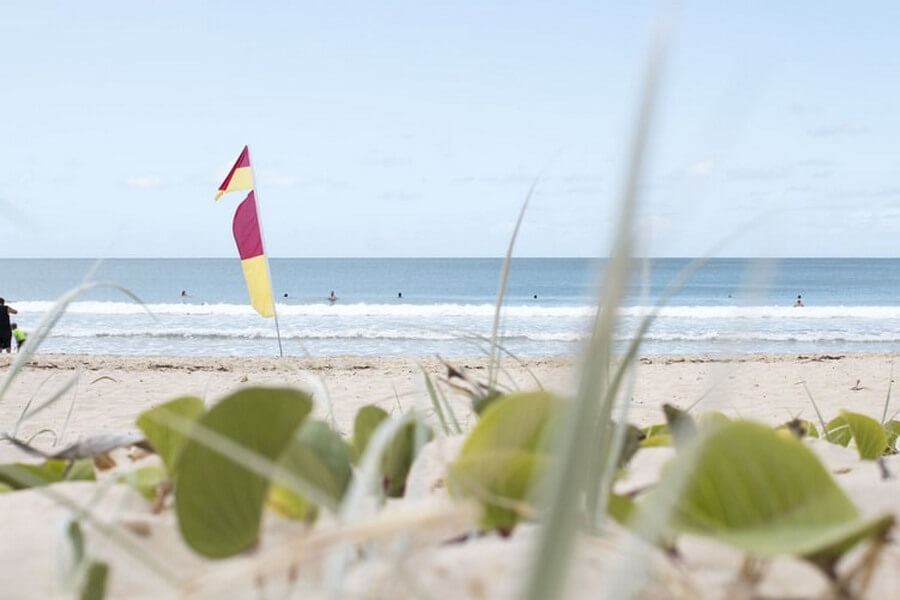
Red flags alone mean the swimming area is closed and no one should enter. Alternatively, if there are no flags at all, no swimming should take place. Blue flags indicate that no surf crafts are permitted in the waters (no surfing equipment at all).
Yellow flags alone mean that the water poses some sort of danger or hazard. The red and white quartered flags are a signal of emergency.
Knowing all these flag colours will ensure that every single precaution is considered and taken very seriously.
Learn How to Identify a Jellyfish
This may seem obvious, however, it is still critical. In order to practice alertness for stingers, knowing what to look for is important
These tentacles will appear flat and noodle-like. These incredible tentacles can stretch to an impressive 3m. While they are a pale blue colouring and transparent, they can still be seen in certain circumstances.

Wear Protective Swimming Clothing
Swimming clothing or bathing suits are quite different in Australia than in other countries. This is because of the dangers on the beach and within the waters at the beach. Things like extreme sun exposure and aquatic life that is dangerous play large roles in the bathing suits worn in Australia.
Sure, people wear bikinis and regular swimwear, however, these simply won’t do all of the time. This is especially true in the case of swimming in Australian waters. In an attempt to stay safe while in these beautiful waters, proper swim clothing is a necessity.
The extreme needs for safety have helped bathing suits become transformed throughout the years. They have become more streamlined looking and are tight-fitting to make swimming safe in rougher tides.
Moreover, the variations of bathers also include longer sleeves and longer length to cover up legs. This full covered look protects any open skin areas that a stinger can penetrate.
Swim shoes should also always be worn. While a stinger can still get through a suit, it will not penetrate as deeply. It is absolutely an essential idea to wear these bathers to create an extra layer of protection will in the waters.
Sure, marine stingers are a danger, but they should not scare off people from entering the water.
Watch for Posted Signs At the Beach
Flags are helpful within the waters but there are also posted signs in place around the beaches as well. Every extra step that can be taken usually is taken. In this case, the posted signs are yellow with black wording in diamond shapes and writing showing what dangers lurk around the beach.
This can obviously include marine stingers, crocs, kangaroos, etc.
Like the flags, these posted signs can come in other colours. For example, information signs are generally blue and white while regulatory signs come in circular shapes with diagonal lines through them.
Safety signs for in place safety precautions are usually green and white.
Ask Questions About Beach Safety
No one is perfect and it is impossible and impractical to know every single thing. This includes knowing what sandbars in the water look like or even how to know the difference between certain tides. All of these questions can be answered quite easily.
When at a patrolled beach the lifeguards are obviously there to save lives during emergencies. They are also there to answer any potential questions that come up. This makes a great means for resources and in a way their knowledge that they share also helps saves lives.
People should never be afraid to ask these questions. A lifeguard serious about enforcing safety will have absolutely no problem (nor should they judge!) answering these questions.
These are the top ideas for staying safe at the beach. They are in no way meant to keep people away from the waters in Australia. In fact, they are more of a shed of light on how fun can be still be had even where there are dangers lurking.
They also help people understand that even with lifeguards everyone should still be aware of the surroundings. If someone is in danger or has been bitten by a marine stinger, proper steps can be taken to help relieve their pain and help their survival rate.
This is the overall reason why beach safety in Australia should be properly followed and taken ever so seriously!
Beach Safety Australia: Rips
Going to the beach is a wonderful experience and there are so many activities to do here. Many of these activities will take place in the water and this is an environment in which you need to be very mindful and aware of potential hazards.
One such hazard is getting caught up in a rip, this can be extremely dangerous and even life-threatening if you are not prepared for how to handle this situation should it arise. In this article, we are going to provide you with all the information you need to know in order to stay safe in the water.
What Is A Rip?
The full term for a rip is a rip current, these are a type of current which are found near beaches and where waves are prevalent. A rip
Rips tend to be very strong when they are near the surface of the water.
In many cases, a rip is not strong enough to be a potential hazard but given the right conditions, they can be much more dangerous.
The average width of a rip is between ten and twenty feet and it may be very surprising to learn that some can last for mere seconds whilst others can remain for many years. In the case of the latter, beach patrols will be aware and local information provided.
You may hear a rip being referred to in a variety of ways such as a riptide, which is misleading as this is not a type of tidal activity.
The problem with rip currents is that due to their extremely strong nature, in some cases, they are easily able to drag people out to sea in a very small amount of time.
What Are The Dangers Of A Rip?
A simple description of a rip may not do justice to how dangerous they can really be, especially if you are not a strong swimmer. It is important to be aware of why rips can be so dangerous and respect them.
Getting caught in a rip may cause exhaustion from trying to fight it, this, in turn, can lead to drowning from simply not having the energy to stay afloat any longer.
In addition to the above point, rips can be a source of fear once you are caught in one and this sense of panic can cause you to lose control very easily.
Even if you are a very strong swimmer, a rip can overpower you.
The number of deaths from being caught in a rip is, in fact, ten times higher than the number of shark attacks in Australia every year!
How Do I Spot A Rip?
For those with no knowledge of a rip, it can be easy to be completely unaware of their presence, it is, therefore, very important that you learn what to look for to avoid getting caught up.
Where Do Rips Usually Occur?
- Rips occur close to the shore, usually underneath breaking waves.
- They occur at a break in a sandbar.
- Rips can be found near both man-made and natural structures such as piers and jetties.
What To Look For To Spot A Rip.
Before entering the water, if you can head to higher ground, this is an excellent vantage point to check the ocean for rips. This is something which many experienced surfers will do before heading into the sea.
Look for areas of water which are darker in colour and deeper looking than the rest of the location.
If a rip is present there are likely to be fewer incoming breaking waves.
If you notice an area of water with a rippled surface that is surrounded by calmer waters, this is an indication that a rip is present.
Beach material such as sand and seaweed will be present in the backs of the waves as it is being pulled out to sea by the underlying rip.
How To Avoid A Rip
Before we get onto what to do if you find yourself caught in a rip, we are going to take a look at some useful information about how to avoid getting caught up in the first place.
Using your common sense can go a long way in keeping you safe, but there are some other things you can do to ensure that you avoid potential danger in the form of a rip.
As we mentioned above, take the time to inspect the area for rips, this way you can avoid entering one and perhaps choose to swim, surf or take part in other water-based activities on another day.
Speak to local lifeguards and heed local safety information such as the flag system. If it is advised not to go into the water, you should take this information seriously.
If you are going to enter the water, always make sure that you are on a patrolled beach where help can be accessed easily should you find yourself in a spot of bother.
What To Do If You Are Caught In A Rip
The most important thing to remember if you are unfortunate enough to get swept up by a rip is to remain as calm as you can. As we mentioned previously, rips can be so dangerous when you begin to panic.
Keeping a calm head and remaining rational and logical will greatly aid your chances of survival. Let’s look at some other great tips for what to do in an emergency situation.
Signal for help as soon as you can, whilst help is on its way, you can follow the next steps.
Never try to swim against the rip, this will not serve you and will simply result in exhaustion.
Swim parallel to the rip in order to break free at its end and once you have done so, you can then exit the water at the shore.
If the water is shallow enough that you are able to stand, you should attempt to wade through rather than swimming.
Following local safety advice
Getting caught in a rip is something that Australian lifeguards have to rescue people from every day of the year, however, there are ways that you can avoid being the next victim. It is important to know what to look for as well as following local safety advice, this will be your greatest defence.
However, if you do find yourself caught in a rip, you can follow the above tips to successfully escape and get safely back to shore. Read on here about how beaches are formed.
More Pages On Beaches
Not all beaches are suitable for swimming for a number of reasons. Some of these areas are more practical for sand activities or photography. It is important to know whether or not a beach is safe...
Visiting the beach is a beautiful opportunity to see mother nature at its best. There's nothing quite like hearing the waves rolling in on a soft, sandy shoreline. While visiting the beach is a...


